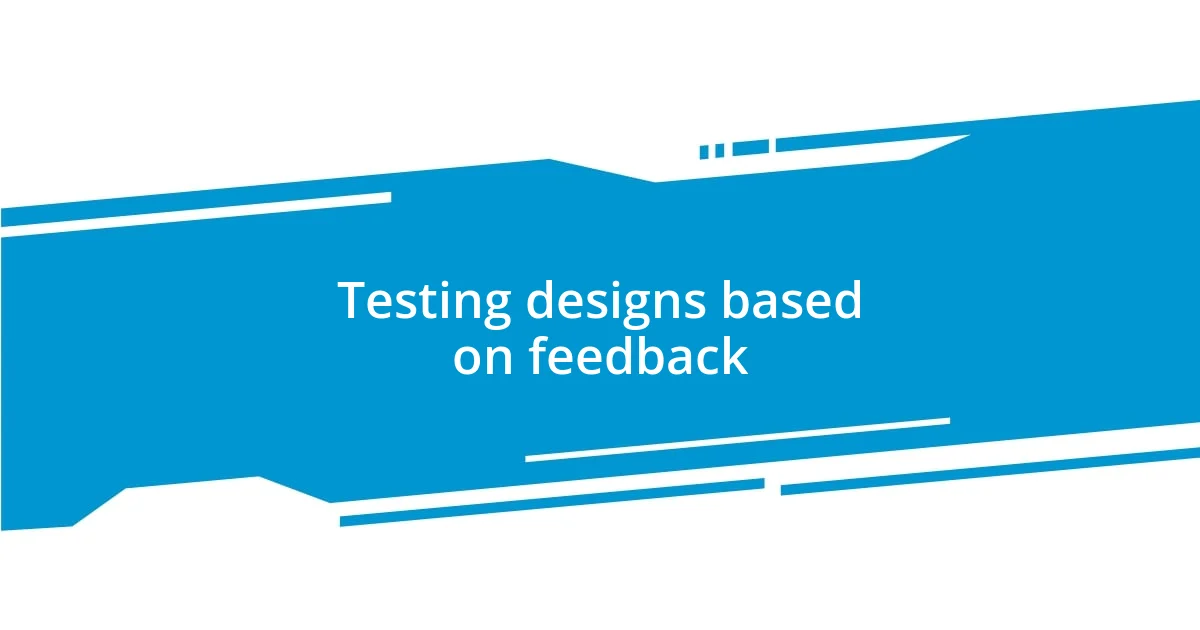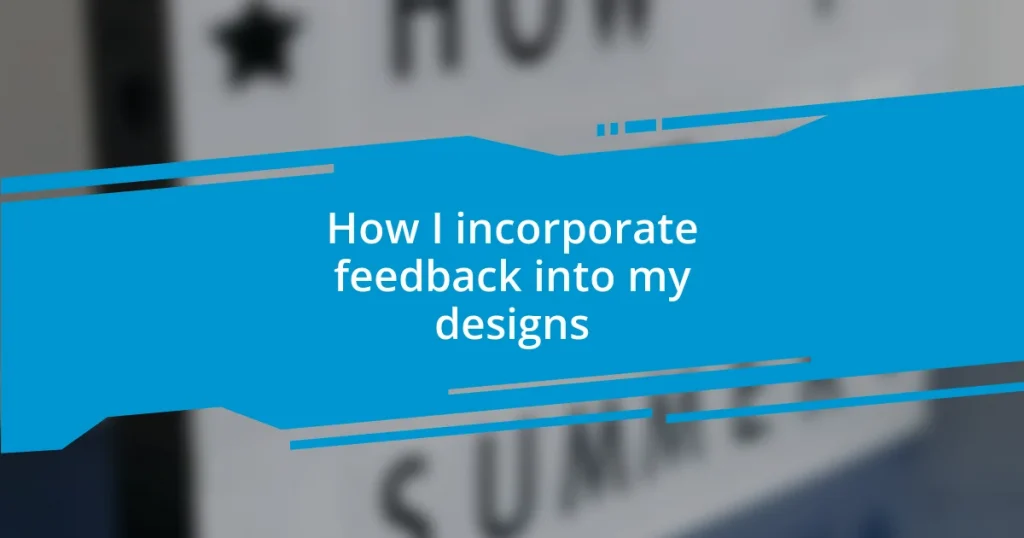Key takeaways:
- Feedback serves as an essential tool for growth, allowing designers to see their work from different perspectives and enhance their creations.
- Establishing effective feedback channels, including safe environments and diverse sources, fosters constructive dialogues that lead to innovative design improvements.
- Testing designs based on feedback is crucial, as it helps identify usability issues and ensures the design resonates with users’ emotional experiences.

Understanding the importance of feedback
Feedback is more than just words; it’s a mirror reflecting how others perceive our designs. I recall a project where I thought I had created something innovative, only to realize through feedback that my audience found it confusing. This experience taught me that understanding others’ viewpoints can be a wealth of insight that truly enhances my work.
It’s fascinating how feedback can transform a mere idea into something extraordinary. Have you ever felt that rush when a suggestion clicks? I certainly have. After receiving constructive criticism on a color scheme I was attached to, I was hesitant but willing. When I made the changes, the design not only popped but also resonated deeply with my audience, showing me the power of collective input.
Furthermore, feedback allows for growth. Each piece of advice is a lesson learned, shaping my journey as a designer. Embracing feedback has shifted my perspective; it’s no longer something I dread but rather an opportunity. Isn’t it incredible that a few comments can elevate our work to levels we’ve never imagined?

Identifying sources of feedback
Identifying sources of feedback can be a bit of a treasure hunt. I often start by looking at my immediate circle—friends, family, and colleagues. These individuals provide a blend of support and honesty that can be invaluable. Once, a friend pointed out a design flaw I had overlooked for weeks, which ended up being a game-changer. It’s a reminder that those closest to us often have the clearest perspective.
Another fruitful source is professional networks and design communities. Engaging with like-minded creators allows for a broader array of opinions. Having participated in several design forums, I’ve found that sharing my work and asking for critique often leads to enlightening discussions. This outside perspective has pushed me toward more innovative solutions.
Lastly, I turn to user feedback, which can come directly from testing phases or surveys. Seeing a design in action is entirely different from how I envision it. Just the other day, after conducting a user survey for my latest project, the insights I gained reshaped my design completely. It’s moments like these that highlight the importance of real-world interaction with my work.
| Source of Feedback | Characteristics |
|---|---|
| Friends and Family | Immediate and honest, often provides emotional support. |
| Professional Networks | Diverse opinions, fosters creative growth, and encourages innovation. |
| User Feedback | Real-world insights, highlights practical usability, and reveals blind spots. |

Establishing effective feedback channels
Establishing effective feedback channels is crucial for any designer aiming to grow. I like to think of my feedback channels as a network of pathways. Each route leads to different perspectives that can sharpen my designs. For instance, I regularly schedule brainstorming sessions with my team, where everyone feels comfortable sharing their thoughts—no idea is too small or too weird. This open dialogue often sparks unexpected insights that I hadn’t considered before.
To ensure these channels remain effective, I focus on certain key strategies:
- Create a safe environment: Encourage honesty and openness by showing appreciation for all feedback.
- Utilize various platforms: Incorporate feedback sessions ranging from casual chats to structured surveys, allowing for different forms of expression.
- Establish a routine: Regularly scheduled feedback sessions help normalize the process, making it a central part of my design workflow.
- Encourage specific feedback: Instead of vague comments, I ask targeted questions to guide the conversation, which usually results in more actionable insights.
When I incorporate feedback channels thoughtfully, I find that the resulting dialogues often lead to unexpected but delightful design advancements. Just recently, I implemented a new approach, inviting non-designers to take a look at my projects. Their fresh eyes delivered comments I wouldn’t have considered otherwise, and the result was a design shift that reignited my excitement about the project. It’s experiences like these that reinforce how vital it is to keep those channels flowing.

Analyzing and prioritizing received feedback
Analyzing feedback is like picking through a fruit basket; some pieces are ripe with insight, while others may need to be set aside. When I receive feedback, my first step is to categorize it. Is it technical, conceptual, or emotional? I often jot down the feedback in a notebook, giving each piece weight before deciding its importance. A few months back, I received mixed responses on a user interface design I was excited about. By analyzing those comments, I found a recurring theme that illuminated a critical usability issue I had initially dismissed.
Prioritizing feedback effectively is essential. It’s tempting to address every comment, but that often leads to chaos. Instead, I think about the impact each piece of feedback could have on my design. I rely on a simple method: I rank the feedback against my project goals. If a suggestion aligns closely with enhancing user experience or addressing a clear pain point, it takes precedence. I remember once when I was knee-deep in a project, and a colleague pointed out how a specific feature could confuse users. Initially, I was hesitant, but after prioritizing that feedback, it led to a design overhaul that ultimately increased engagement.
At times, I find it helpful to reflect on my emotional connection to the feedback. Does a piece of feedback resonate with current trends or personal experiences? Emotional insights often enhance the analytical side of prioritization. For example, in a recent project, the feedback I received about color choices struck a chord with me; not only was it valid, but it also reminded me of my own journey as a designer. By marrying emotional responses with analytical evaluation, I can refine my designs in a way that truly resonates with both my vision and my audience. It’s in this process that I often discover the real magic of creating something meaningful.

Integrating feedback into design iterations
Integrating feedback into my design iterations feels like adding spices to a well-cooked dish; the right seasoning can elevate a good design to something truly unforgettable. I often revisit the comments gathered during feedback sessions, looking for patterns that emerge—it’s amazing how one observation can connect several dots I hadn’t noticed before. For instance, when I was working on a mobile app interface, several users remarked about a certain button being too small. Instead of brushing it off, I took this feedback to heart and revamped that element, leading to a substantial improvement in user satisfaction.
I’ve learned that the timing of incorporating feedback is just as crucial as the feedback itself. Sometimes, I wait until a design is in a disarrayed state before inviting input, keen to see how others find their way through the chaos. This not only brings clarity to the pathways I might have missed but ignites conversations that shift my design perspective. Recently, a colleague suggested a complete overhaul in the layout based on our user testing phase, prompting me to rethink my initial vision. Who would have thought that embracing vulnerability could lead to such a rewarding creative breakthrough?
Finally, I’ve come to appreciate the iterative nature of design as a dialogue rather than a monologue. Each round of feedback feels like an opportunity for growth, akin to learning a new dance. With every iteration, I refine not only my design but also my approach to collecting and integrating feedback. It’s a dynamic cycle where I ask myself: How can I make my designs not just good, but meaningful? Every small adjustment brings me closer to answering that question, infusing my work with the wisdom and experiences shared by others.

Testing designs based on feedback
Testing designs based on feedback is a thrilling part of the creative process for me. When I roll out a new design, I often feel a rush of nerves. I remember launching a website redesign that I believed was flawless, only to discover through user testing that navigation was confusing. Seeing real users struggle was initially disheartening, but it was also a pivotal moment—I realized the power of feedback in shaping a more intuitive experience.
After receiving that valuable insight, I quickly set up another round of tests. This time, I focused on how users interacted with the updated layout. I watched closely as they navigated, always jotting down their reactions and thoughts. One user mentioned they hesitated before clicking a button due to its placement, and I instantly understood: it wasn’t just about aesthetics, but about making an action feel natural. These firsthand observations reinforced that testing is not just about gathering feedback but about understanding the emotional journey users undertake.
Ultimately, testing designs based on feedback is like fine-tuning an instrument. Every session reveals a new note that can harmonize the overall composition. I often ask myself, “What is the essence of my design, and how can feedback help me convey that?” Each response, whether positive or negative, becomes a stepping stone toward creating something that resonates on a deeper level with my audience. It transforms my work from a solitary endeavor into a collaborative symphony.














